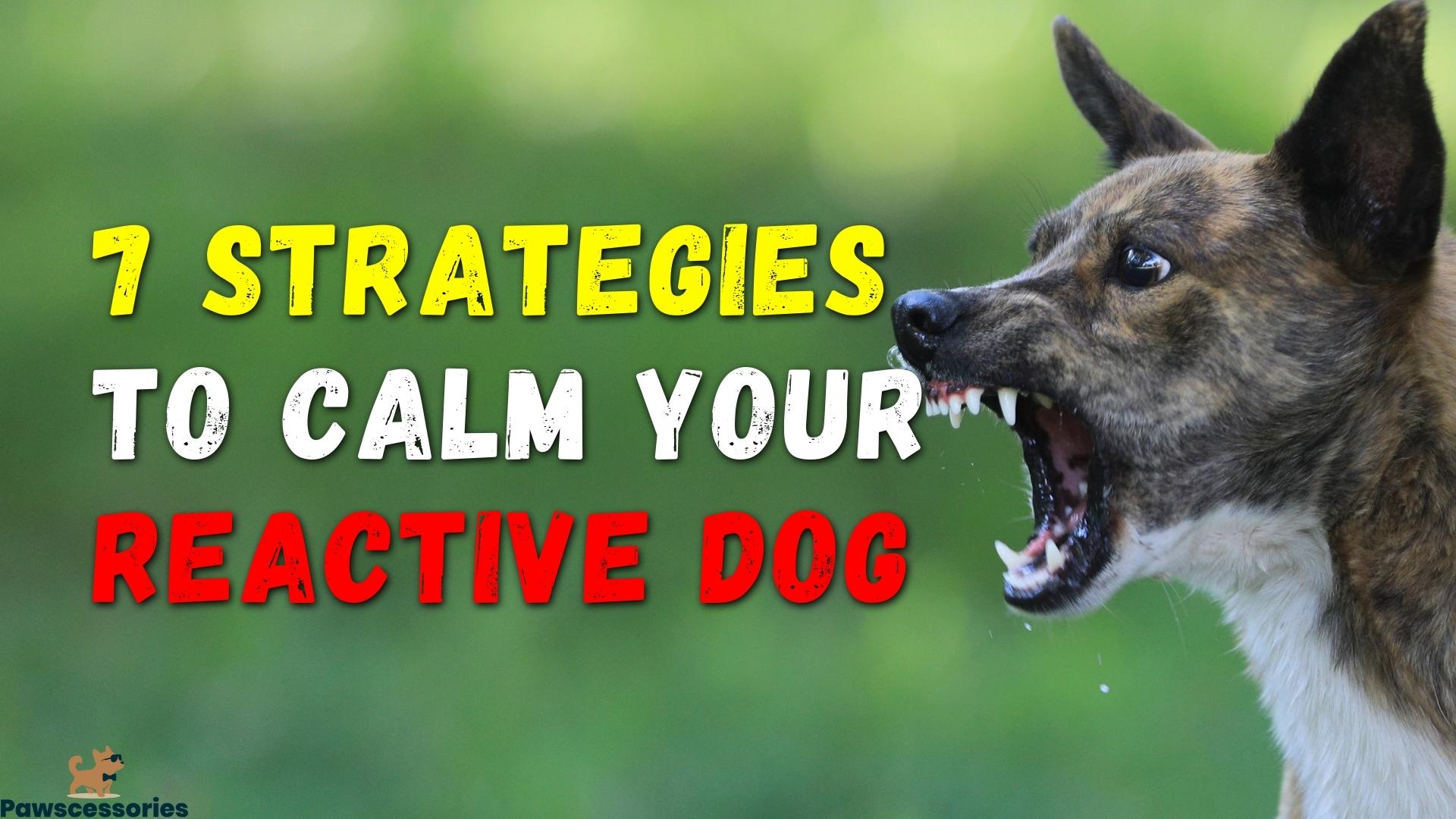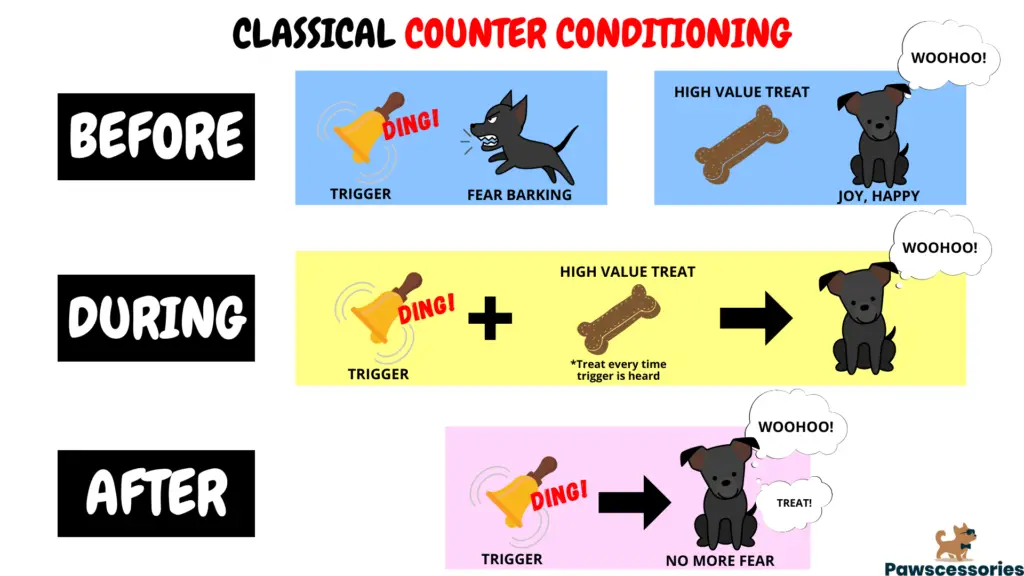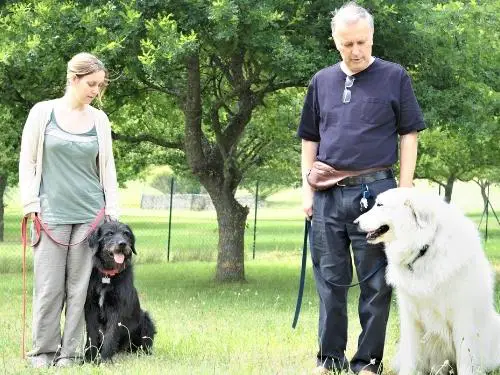Pawscessories is reader-supported. When you buy via links on our site, we may earn an affiliate commission at no cost to you.
Learn more.
You decide to take your pup for a walk. It’s a beautiful summer day, clear skies, birds singing, and a delicious coffee in your hand.
You look down at the end of the leash and your pup has stopped moving and is staring intensely at another dog down the street. You can tell something’s off.
As the dog gets closer your dog begins to growl and tense up. Things only get worse as they begin to bark, start trying to lung, and totally lose control.
Your perfect walk has now turned into a nightmare.
Dog reactivity isn’t uncommon. In fact, 1 out of 3 dogs have an issue with reactivity.
The good news is calming a reactive dog can be done with a few simple strategies.
In this post we reveal:
- What dog reactivity is and why it develops
- Reactivity vs. aggression
- 7 steps you can take to train your reactive dog
- A dog reactivity chart to help identify your dogs mindset
- And more
Let’s dive in.
Table of Contents

What Is A Reactive Dog?
Dog reactivity is defined as a dog that gets overly excited, stressed, or anxious in the presence of certain triggers.
These triggers can be anything from other dogs, people, animals, objects, movement, and even sounds.
Reactive dog behavior can manifest itself in many different ways including barking, growling, lunging, snapping, and even biting.
It’s important to note that dog reactivity is not aggression.
Aggression is a serious issue and is characterized by intentionally harmful behavior towards people or other animals.
Reactivity, on the other hand, is usually the result of fear, stress, or anxiety. But what actually causes them to develop this reactivity towards things?
What Causes A Dog To Be Reactive?
There are many different factors that can contribute to dog reactivity, including:
Lack of Socialization
Dogs that haven’t been properly socialized early on in life are more likely to develop dog reactivity. This is because they haven’t had the chance to learn how to interact with other dogs and people in a positive way.
Rescued Dogs
Dogs that have been rescued from shelters or abusive homes are also more prone to dog reactivity. This is often due to the trauma they’ve experienced which can make them fearful of other dogs and people.
Genetic Disposition
Some dog breeds are simply more prone to dog reactivity than others. This is due to their genes and cannot be changed. Breeds that are more likely to be reactive include herding dogs, terriers, and sighthounds.
Poor Nutrition
Dogs that are not well-nourished are also more likely to develop dog reactivity. This is because they lack the nutrients necessary for a healthy nervous system which
Improper Training
Dogs that have not received proper training are also more likely to be reactive. This is because they haven’t learned how to properly interact with other dogs and people. In addition, some dog owner may unintentionally train their dogs to be MORE reactive.
Trauma
Dogs that have experienced some sort of trauma are also more likely to develop dog reactivity. This could be anything from being attacked by another dog to being in a car accident.
High Energy Dogs
Dogs that are high energy by nature are also more likely to be reactive. This is because they have a lot of pent-up energy that needs to be released. Without an outlet, this energy can build up and cause dog reactivity.
How Can You Tell Your Dog Is Being Reactive?
In order to determine if your dog is reactive you’ll need to look for certain signs and behavioral cues.
As mentioned, reactivity is different from being aggressive. That being said, there are still some similarities between the two. Here are a few signs that can indicate your dog is being reactive:
- Barking
- Growling
- Lunging
- Snapping
- Freezing
- Hesitation
- Cowering
- Tail Tucking
- Yawning
- Lip Licking
- Panting
- Avoidance
These are just a few of the signs your dog may be exhibiting if they’re being reactive.
My dog Enzo used to be reactive. He would lung, bark, and snap towards other dogs. I knew it wasn’t aggression because his interactions with other dogs and people was always extremely friendly.
He would just bark and lung out of excitement since he wanted to play. So if you know your dog is friendly and playful but acts like a crazy dog in certain settings, they’re likely a reactive dog.
It’s important to note that not all dogs will show the same signs and some may only exhibit a few while others will show many.
How To Train A Reactive Dog In 7 Simple Steps
Here are 7 steps to train a reactive dog:
- Identify Triggers & Desensitize Them
- Set Up A Routine
- Get The Right Equipment
- Understand Body Language Cues
- Control The Environment
- Get Professional Help
- Never Respond With Anger & Frustration
1) Identify Triggers & Desensitize Them
There are a number of reasons a dog can be reactive.
The key with calming your dog when they get reactive is to first understand what’s causing them to behave this way.
This could be another dog, the mail man, fear of thunder, your pup may have experienced a traumatic event, etc. The list goes on and on.
There are so many different causes for reactivity that the first, most important thing to do is identify what their trigger is/are.
Here’s an easy system to follow:

- Closely watch your dog and write down or take a mental note of what seems to always be their trigger.
- Pair their trigger with something your dog enjoys. This can be high value treats (cheese, chicken, meat etc.), toys, or even something like the jingle from another dog’s collar.
- Depending on the severity of your dog’s response to the trigger you’ll need to prepare in advance. This means training them first before bringing them into an environment where their actual trigger may appear.
- When you’ve identified your dog’s trigger, work to desensitize it. For example, if your dog is scared of thunder, quietly play thunder sounds then simultaneously give them a high value treat or something else they really like. Over time this will help desensitize your pup to the sound that causes them to act out. This process is the same for any trigger.
*If your dog is reactive to other dogs, socialization with other dogs will help desensitize them. Make sure to still pair this with something they enjoy.
If you’re someone who has been struggling to train your reactive dog, you may want to consider one of these in depth online dog training programs.
2) Set Up A Routine
Now that you have the dog reactivity training structure down, it’s time to set up a routine to complete your dog training. This will take time, patience, and consistency.
For any successful training strategy a schedule and routine is the ultimate key to success.
Dogs thrive on consistency so make sure to set up a routine and stick to it.
A good idea is to create a plan to train your dog every day for at least 10 minutes. If you’re not consistent with this nothing will change.
No schedule is completely fixed, your dog will grow and learn so things may change and should be shifted as often as needed.
For example, when your dog starts to become more desensitized to the trigger it might be time to move your training into real world scenarios.
3) Get The Right Equipment
When dealing with a reactive dog you want to set yourself up for success with the right tools.
The right equipment allows you to better control your dog and their emotional state when triggers present themselves.
Depending on how your dog responds to their trigger will depend on what tools you will need to help.
If your dog is reactive on walks and tends to bark, pull, and lung, you might want to consider a gentle leader or easy walk harness.
These items help control your dogs pulling on leashes and give you better control.
When dealing with reactivity in your home you can use a crate.
Not only will a crate help reduce reactivity but it ensures safety for both your dog and any other dog or person that may cause their reactivity.
Dogs with proper crate training treat their crate as a safe space.
So if you know your dog is reactive when other people visit or when traveling to the vet, you can use a crate to put them at ease and reduce reactivity.
4) Understand Body Language Cues (Dog Reactivity Chart)
One of our jobs as dog owners is to be able to identify when our dogs are signaling stress or discomfort.
The best way to determine this is through their body language.
By understanding different signals your dog gives off, we can better diffuse situations that could otherwise get out of hand.
I have attached a dog reactivity chart below to help you identify when your dog is getting into a reactive state.
When you see a trigger approaching your dog, use this dog reactivity chart to help determine your dog’s state:
Keep in mind there are tons of little signals a dog can give off that are not mentioned in this chart.
However, these cover the most common order of responses that are likely to occur for reactive dogs.
5) Control The Environment
One of the most important aspects of dog training is controlling your dog’s environment. This allows you to limit their exposure and self-reinforcement.
That way reactivity decreases because there’s less opportunity present.
This also gives you more opportunity to train them with a better habit and desensitize their triggers.
If your dog is reactive when you take them on walks, try controlling their environment by planning getaways or different paths you can take to avoid scenarios.
I used to do this all the time with my dog Enzo when he used to be reactive towards other dogs and people.
I would just walk to the other side of the road whenever I saw another dog coming, I would even plan to take him out later in the day when I knew less people were around.
Another example would be for those of you with a dog that loves barking out the window at other dogs.
In this example all you have to do is close the blinds so there is no longer anything to look at and be triggered by.
6) Get Professional Help
Depending on the severity of your dog’s reactivity, one of the fastest ways to get this problem solved is to go to the experts.
Although it can be quite expensive to have trainers take your dog it can be one of the best choices for some.
Another option is to get specialized training online. It’s really cheap but requires you to put in the work.
Now I’ll be the first to admit a lot of online programs are not very good. We’ve reviewed a ton of really bad dog training programs.
However, I’ve recently found one that’s actually worth recommending.
If you’re in need of some extra help that is much more in depth and specific to your dog, you may want to consider enrolling in an online dog training course.
Related Reading: Top 9 Best Online Dog Training Courses

7.) Never Respond With Anger & Frustration
Be patient and tolerant of your dog’s reactivity. They’re emotional and cannot help themselves.
If you get mad and frustrated it’ll often lead to yelling, yanking your dog when they pull on leash, etc.
These things cause the reactivity to become reinforced and only makes things worse.
For example, if your dog is barking and you start yelling at them, your dog has no idea why you’re yelling.
In fact, they might actually think you’re yelling with them which to them means it’s okay for them to be reacting as they are.
Stick to positive reinforcement and avoid punishment. Only reward your dog when they behave the way you want and when they misbehave, stay calm and be patient.
Your dog is not being “bad”, they’re just acting in a primitive way. They are on high alert set off by their fight or flight response.
Other Frequently Asked Questions
Why Is My Dog Becoming More Reactive?
There are a number of reasons why dogs can become more reactive. It could be due to an increase in anxiety, a change in environment, or even something as simple as a lack of exercise. If you think your dog is becoming more reactive, it’s important to first rule out any medical causes. Once you’ve done that, you can start to look at other factors that may be contributing to the problem.
What Are The Most Reactive/Aggressive Dog Breeds?
While any dog can become reactive, there are certain dog breeds that are more prone to it. These include herding dogs, hunting dogs, and guarding dog breeds. This is becasue these dog breeds were bred for specific purposes that required them to be more reactive to their environment. As working dogs they were required to have a higher level of vigilance and be able to respond quickly to any potential threats.
Can Adult Dog Reactivity Be Fixed?
The short answer is yes. Dog reactivity can be fixed at any age. However, it’s important to note that the older a dog is, the harder it is to change their behavior. This is because dogs tend to become more set in their ways as they get older. That’s not to say it can’t be done, but it will take more time, patience, and effort.
Final Thoughts
Reactivity is often misunderstood because it can be mistaken for “ aggression”.
However, dog reactivity is simply a dog’s way of warning you that they are feeling uncomfortable, threatened or scared.
Reactivity is often the result of a dog feeling anxious, stressed or afraid.
The good news is, dog reactivity is a behavior that can be changed with proper dog training.
If you have a reactive dog, there are several things you can do to help them feel more comfortable and less triggered.
Remember to be patient, consistent and never punish your dog for being reactive. Positive reinforcement is always the best way to train your reactive dog.
